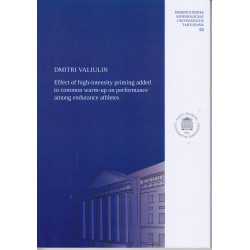



Tartu : University of Tartu Press, 2022
103 p.
ISBN: 9789949039715
Paperback, in very good condition.
Theses(doctorate). A traditional warm-up process combines low-intensity aerobic exercise, followed by stretching and sports-specific warm-up. High-intensity and low-volume preload by non-sport-specific muscle groups can also generate systemic changes that increase body's readiness and improve oxygen uptake during the subsequent performance test. The purpose of this study was to determine whether high-intensity priming exercise executed by non-sport specific muscles improves outcomes of subsequent sport-specific performance test. The additional objective was to assess the metabolic response to high-intensity priming exercise and estimate the magnitude of the anaerobic energy contribution to the total energy supply. The subjects completed two competitive trials at a maximal power, both were preceded by low-intensity warm-up (20 min), but in one case a high-intensity low-volume anaerobic pre-load (25 sec) was added. The study protocols varied in terms of recovery time, duration of the performance test, and pace. In conclusion, pre-load did not improve performance during subsequent maximal performance test; however, positive responses observed at the individual level suggest that some subjects may benefit from this method. Priming lowered net lactate increase and respectively the total anaerobic energy contribution during subsequent maximal performance test. However, it was observed that at submaximal intensity and a steady pace, exercise tolerance and economy improved.
Series: Dissertationes kinesiologiae Universitatis Tartuensis ; 53. Summary in Estonian